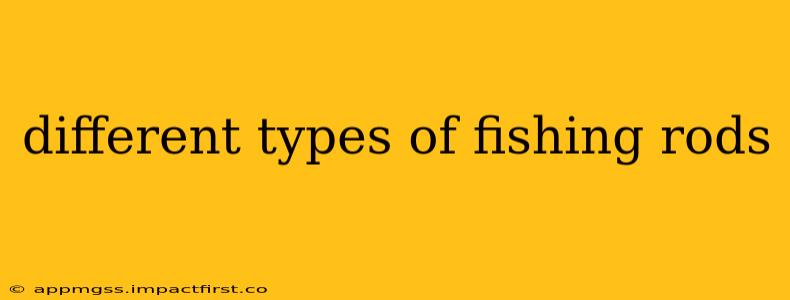Fishing rods are far more diverse than many anglers initially realize. Choosing the right rod can significantly impact your success, comfort, and overall enjoyment of the sport. This comprehensive guide will explore the various types of fishing rods, highlighting their key features and ideal applications. Understanding these differences will empower you to select the perfect tool for your next fishing adventure.
What are the Main Types of Fishing Rods?
The world of fishing rods is vast, but we can categorize them based on several key factors: material, action, power, length, and intended use. Let's break down these categories:
Material:
-
Fiberglass: Fiberglass rods are known for their durability, affordability, and flexibility. They offer excellent forgiveness, making them a great choice for beginners and anglers targeting smaller, more delicate fish. They tend to be heavier than other materials.
-
Graphite (Carbon Fiber): Graphite rods are lighter, stronger, and more sensitive than fiberglass rods. They provide superior casting distance and accuracy, making them popular among experienced anglers targeting a wider range of species. Higher-end graphite rods can be quite expensive.
-
Composite: Composite rods blend fiberglass and graphite, combining the benefits of both materials. These rods often offer a balance of durability, sensitivity, and affordability.
Action:
Rod action refers to how the rod bends under pressure. This is a crucial factor influencing casting and fighting fish.
-
Fast Action: Fast-action rods bend primarily in the tip section. This provides excellent accuracy and sensitivity for precise presentations. They're ideal for techniques like finesse fishing and jigging.
-
Moderate Action: Moderate-action rods bend along a larger portion of the blank (the rod's shaft). They offer a good balance between power and sensitivity, making them versatile for various fishing styles and species.
-
Slow Action: Slow-action rods bend significantly along the entire length of the blank. They provide exceptional hook-setting power and shock absorption, ideal for fighting larger fish.
Power:
Rod power indicates the rod's ability to lift and handle fish. It's typically rated on a scale (e.g., ultra-light, light, medium, medium-heavy, heavy, extra-heavy). The appropriate power depends on the size and strength of the fish you target and the type of lures or bait you use.
Length:
Rod length impacts casting distance, accuracy, and control. Shorter rods provide better control and are easier to maneuver in tight spaces, while longer rods offer greater casting distance. The ideal length depends on your fishing style and the environment.
What are the Different Types of Fishing Rods Based on Their Use?
The type of fishing rod you choose should also align with the type of fishing you plan to do. Here are some examples:
Spinning Rods:
Spinning rods are generally lighter and more versatile, designed for use with spinning reels. They are well-suited for a variety of techniques and fish species.
Baitcasting Rods:
Baitcasting rods are typically more powerful and designed for use with baitcasting reels. They excel at casting heavier lures and are often preferred for targeting larger, stronger fish.
Fly Rods:
Fly rods are specialized rods used in fly fishing, a technique that involves casting artificial flies to mimic insects and other aquatic organisms. They are designed to deliver delicate presentations with long, accurate casts.
Surf Casting Rods:
Surf casting rods are long and powerful, designed to cast heavy lures and baits long distances into the surf. They need to withstand the strong currents and waves.
Ice Fishing Rods:
Ice fishing rods are short and lightweight, designed for use through holes in the ice. They are often highly sensitive to detect subtle bites.
Trolling Rods:
Trolling rods are designed for use while trolling, a technique where lures are dragged behind a moving boat. They are typically sturdy and capable of handling large fish.
What is the best fishing rod for beginners?
For beginners, a medium-power, moderate-action spinning rod made of composite material is an excellent choice. This type of rod offers a good balance of durability, sensitivity, and forgiveness. It's versatile enough for various fishing situations and relatively easy to learn to use.
How do I choose the right fishing rod for me?
Choosing the right fishing rod requires careful consideration of several factors, including:
- Target Species: What kind of fish are you trying to catch?
- Fishing Technique: What methods will you be using (spinning, baitcasting, fly fishing, etc.)?
- Fishing Location: Where will you be fishing (lake, river, ocean, etc.)?
- Budget: How much are you willing to spend?
By carefully considering these factors and researching different rod models, you can select a rod that meets your needs and enhances your fishing experience. Remember, talking to experienced anglers or visiting a reputable tackle shop can be invaluable in making an informed decision.
